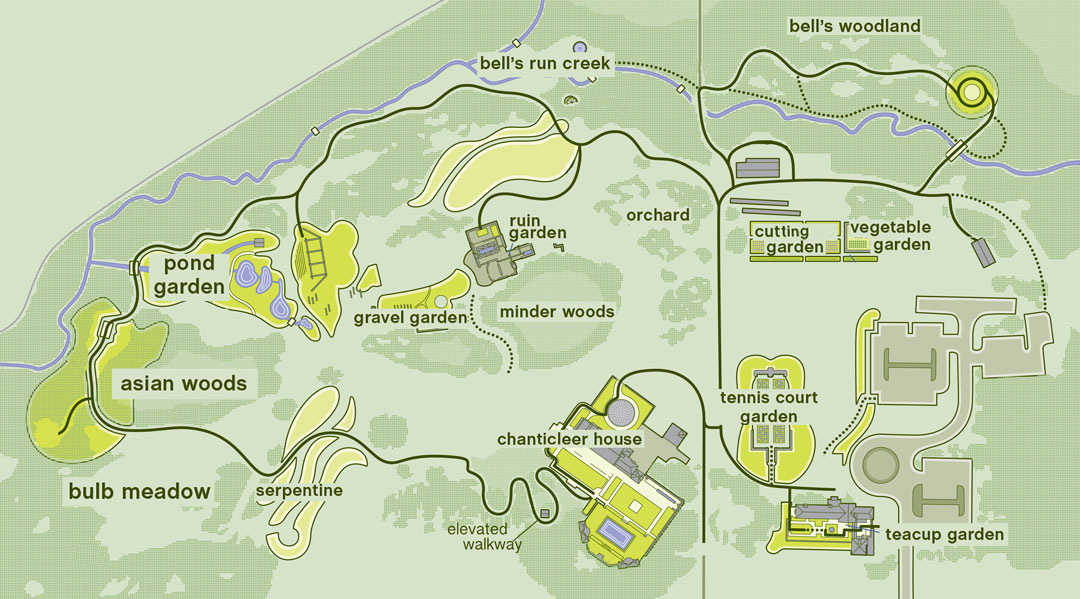
Teacup Garden
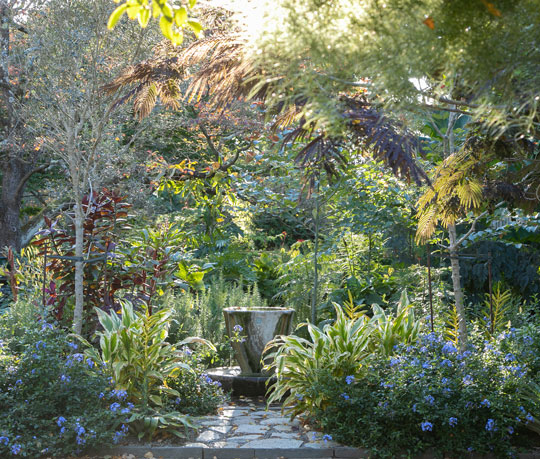
With playful verve, the Teacup Garden takes on a different personality each year. One year it adopts the tropicalismo look, replete with subtropical and tender plants that thrive in our sultry summer nights. Angel trumpets dangle like Christmas ornaments, coleus drip with kaleidoscopic colors that only Jackson Pollock would have dreamed of, and bananas and palms nonchalantly flaunt their gargantuan leaves. Another year it will dramatically transform into a xeriscape of cacti, succulents, and grasses. The only constant is the namesake fountain, , whose sound of trickling water elicits a merriment that matches the seasonal plantings. We believe the Rosengartens purchased the fountain in Florence, Italy, in the 1920s.
Descend the steps to the lower courtyard with an old dogwood tree (Cornus florida), where the planting stays tropical each summer. Bromeliads, ferns, gingers, and palms anchor the shady part, blending with the traditional shade perennials that used to dominate the bed. Close to the house is a warm and sunnier microclimate where marginally hardy plants are sequestered.
Containers are threaded throughout the different areas. Some, such as the giant arum lily, are substantial head-turners positioned strategically to wow while others are small pots marching down the courtyard stairwell or round pots grouped together like a garden on wheels.
On the west side of the house is a hybrid oak (Quercus x saulii) whose impressive size may land it as a contender for one of Pennsylvania’s champion trees. Both the dogwood and the oak were planted soon after the nearby house was built in 1935.
Teacup Garden Video
back to top
The Tennis Court Garden

Once the scene for matches between the Rosengarten family members and their guests, the Tennis Court Garden was the first garden to be developed after Mr. Rosengarten’s death in 1990. The garden now retains its namesake purpose in its rectangular outline and the arc-like shapes of the beds suggestive of a racket’s strokes. Curvilinear yew hedges partition the beds and pathways, prompting an inquisitive sense of adventure. Flaring like bonfires, the shrubby dogwoods (Cornus sericea ‘Cardinal’ and Cornus alba ‘Bud’s Yellow’) and willows (Salix ‘Flame’) brighten the garden before the main plantings rouse in spring and summer. Each bed in the garden is chromatically choreographed, with whites and yellows setting the tone at the base of the stone steps. Hardy hibiscus (Hibiscus ‘Midnight’s Marvel’), kniphofias, and crocosmias (‘Lucifer’) dial the heat up in the central beds. Daylilies, lilies, and native yellow daisies fill the outer beds that benefit from the mature backdrop of conifers, magnolias, and lilacs. On sunny days, visitors can seek shady respite in the Arbor where a staff-made glider beckons them to survey the garden. back to top
Chanticleer House
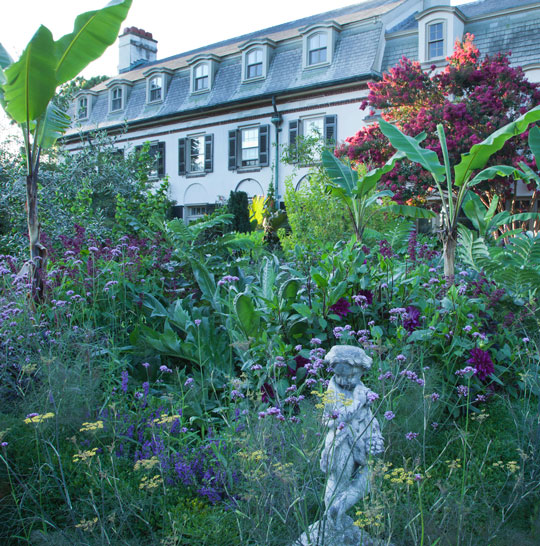
Two roosters set on plinths announce the entrance of the Chanticleer House, designed by architect Charles L. Borie and built in 1913. Originally a summer house, a 1924 addition enlarged it and the family moved here full-time from Philadelphia. The House is open for tours by reservation. The entrance courtyard is an exercise in restraint. Japanese flowering cherries (Prunus ‘Accolade’) underplanted with hydrangeas and hellebores encircle what seems to be a nondescript round panel, reminiscent of when this courtyard was paved for parking.
The Gravel Circle is a feature inspired by the Japanese karesansui or dry landscape garden rooted in Zen ideology. The ritual of raking the gravel into designs that evoke waves or rippling water is said to improve concentration; every week (sometimes daily) one of our staff rakes a pattern to be appreciated from the flagstone path. For a a few days in April, the wavy grooves catch the fallen pink cherry petals and create a choreographed moment of fleeting beauty.
To the side of the house is a sun porch once glassed in and now open to the elements. A favorite of Mrs. Rosengarten, Sr., the porch is popular with our guests who recline on the rocking chairs to read, catch up with friends, or simply relax. There is often a cooling breeze that comes off the hill. In summer, the sun porch resembles a Victorian parlor dripping in the luxuriant foliage of begonias, bird nest’s ferns, cast iron plants, Kentia palms, and staghorn ferns. Outside the sun porch is the overlook bed that like the Teacup Garden, changes seasonally.
Noted landscape architect Thomas Sears designed the terraces that bridge the house and the garden; an ever-changing procession of containers and hanging baskets decorate the space. There is a rectangular piece of lawn where croquet was once played.
Entering the far side of the terrace leads to an unexpected scene – a “flowery lawn” planted on a former turf panel that once necessitated constant maintenance to keep it sharp. This unusual meadow is a favorite spot for bees, butterflies, and hummingbirds that alight on Agastache, purple verbena, and scarlet tassel flower. Framed by a flowering cherry and crape myrtles, a rilled watercourse balances the presence of the swimming pool still in use.
View a pictorial House Tour
back to top
Elevated Walkway

Constructed to improve access and safety, the Elevated Walkway glides over a steep slope that stretches from the Chanticleer House to the Serpentine. Save for a grove of quaking aspens and Persian ironwoods, much of the slope is given over to herbaceous plantings that allow for unobstructed views from the walkway. Perched above these plantings, one can admire how each plant blends into another and one can engage with pollinators like butterflies and hummingbirds at eye level. Of specific interest is prairie dock (Silphium terebinthinaceum), whose yellow, daisy-like flowers borne on 6-8’ stems can be examined closely. Vines cloak the railings, and the native maypop passionflower with its exotic purple blooms and egg-like fruits is worth seeking in summer. back to top
The Serpentine
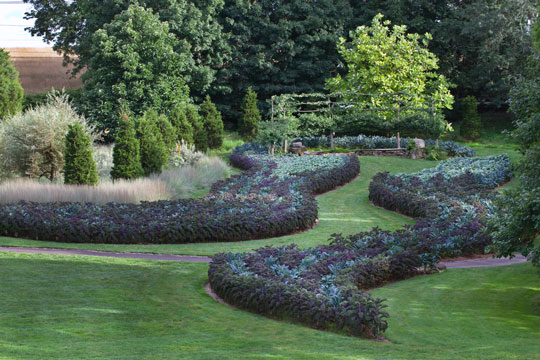
A Tuscan countryside inspired the Serpentine – the silver-leafed willows and junipers stand in for olives and Italian cypresses, Florentine irises under the ginkgoes scent the air in May, and the stone circle suggestive of ancient terraces. The glory of the Serpentine belongs to the rotating cast of agricultural crops planted each year in the two main curved beds – one year was artichokes, another a sea of barley. The planting is an effective way of demonstrating the beauty of agriculture. back to top
Bulb Meadow
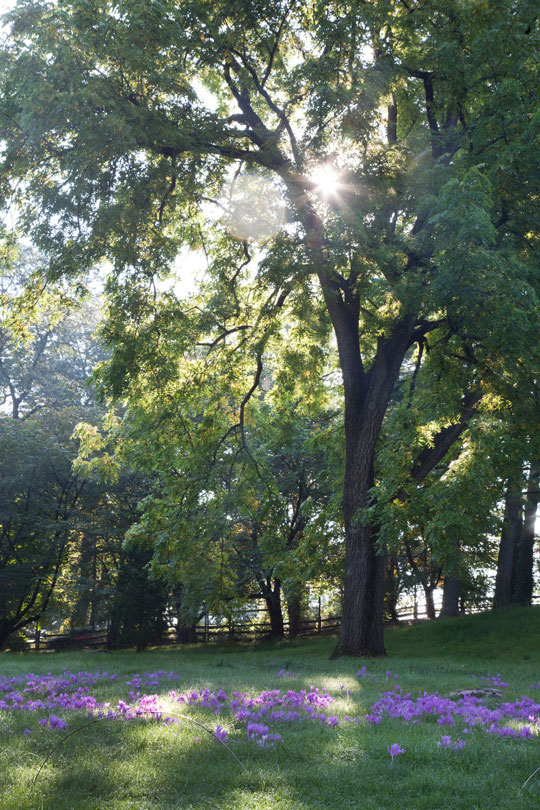
Walk past the Serpentine and you will notice a grassy hillside that features three major bulb displays throughout the year. Daffodils, tulips, and Spanish bluebells grace the hillside in April and May, before fading into the background as the grass begins to lengthen. Later from July through October, surprise lilies (Lycoris) and colchicums each take over the show. These bulbs are unique because early in spring they send up foliage, which produces the nutrients and energy required for leafless flowering in late summer and fall. The maintenance and mowing of the hillside are timed around the blooming and leafing times of the bulb meadow. back to top
Asian Woods
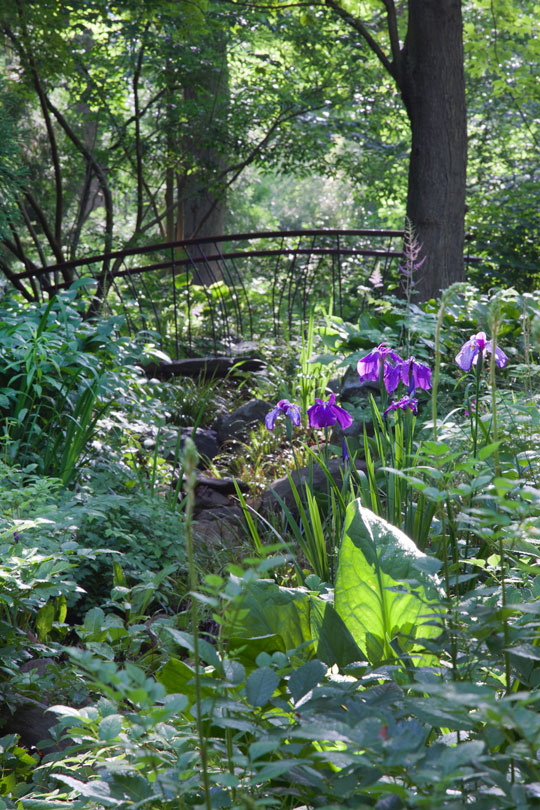
Once a site neglected because of poison ivy, honeysuckle, and euonymus, Asian Woods presents the east Asian flora in the style of a woodland garden. Its peak time arguably is spring when epimediums, fairybells, jack-in-the-pulpits, and primroses burst into bloom with the new shoots of hostas, irises, and Chinese gingers. Non-invasive honeysuckles and climbing hydrangeas are encouraged to scale the tree trunks, and bamboos help screen the road from public view. A modest moss garden is a nod to the Japanese tradition. In summer, Asian Woods is a shady refuge that highlights the pleasure of gardening in cool conditions.
What appears to be a Japanese teahouse is a structure cleverly disguising the restrooms. back to top
Pond Garden
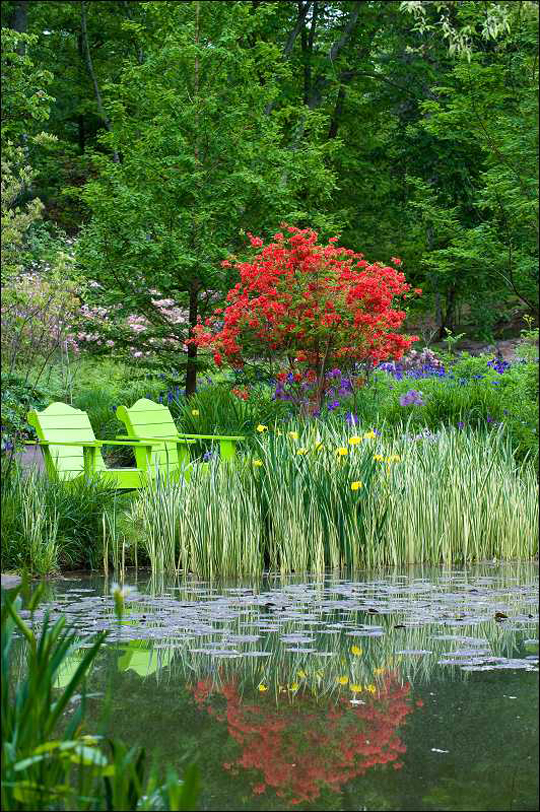
Whether you enter from Asian Woods or the Gravel Garden, the Pond Garden is an ebullient expression of gardening in its naturalistic form. Plantings edge unapologetically over the pathways, blurring the line of sight at various points. Always a major attractant for wildlife, water is the hub of activity—from damsel flies hovering for prey, red-eared slider turtles sunbathing on rocks, and the occasional waterfowl alighting for a break from flying. Shrieks of joy can be heard from children and adults alike when the koi and other fish in the pond are given their afternoon feeding.
The large pond was constructed in the 1970s and remained unplanted to serve as a mirror for the trees that surrounded it. Additional smaller ponds later were built to connect the garden with the wisteria-laden Arbor. A pump located in a modest stone springhouse circulates water throughout the ponds. Plantings now have matured with the ponds whose edges are not visible. One key attraction are the lotuses (Nelumbo ‘Mrs. Perry D. Slocum’) whose voluptuous blooms and sculptural seedpods are a photographer’s delight. back to top
Gravel Garden
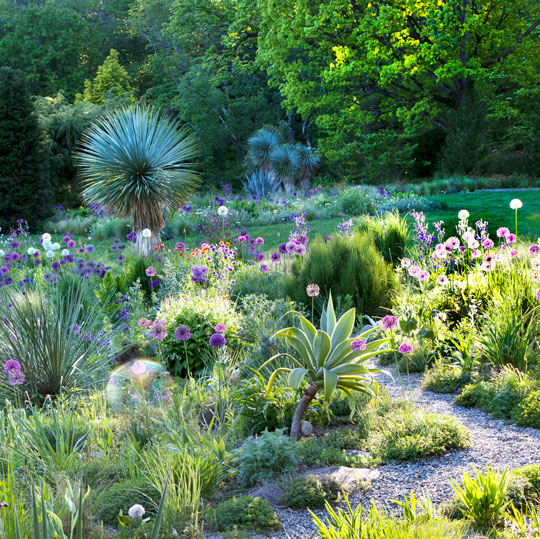
Sun-baked from its southwestern exposure, the Gravel Garden creates a feeling of mounting enchantment as you walk through the series of stone steps. Here the garden eschews plants that need constant irrigation, emphasizing instead tough, resilient plants — all set in a gravel mulch. Silver-leafed lavender, santolina, and thyme add a Mediterranean flavor with their aromas and textures, while spurges writhe like serpents among species tulips and diminutive daffodils. Mexican feather grass (Nassella tenuissima) brings airiness to the structured planting. Narrow spires of juniper (Juniperus virginiana ‘Taylor’) draw the eye up towards the pergola covered with purple wisteria in late spring. Trough plantings offer a viable and aesthetic alternative to conventional, water-thirsty containers. Perhaps the most striking sight are tree-like yuccas with their powder-blue spiky foliage and hula-skirted trunks. Uncommon in the region, Yucca rostrata needs full sun and resents winter wet ground.
Gravel Garden Video
back to top
Ruin Garden

The Ruin stands where Minder House, the residence of Janet and Adolph Rosengarten, Jr., was built in 1925 and remained until 1999 when it was razed to build the Ruin on the old foundation. The Ruin has three rooms: a "Great Hall" with a water table shaped like a large sarcophagus resting on a mosaic "rug" of tile, granite and slate; a "Library" where the books are sculpted of stone; and a "Pool Room,” where marble faces gaze up from the depths. Accenting the spaces are carved stone pieces sculpted by Marcia Donahue, including large stone acorns placed among oak saplings greet visitors entering from the nearby meadow.
The Ruin’s granite schist walls provide the perfect stage for climbing plants and espaliered trees. These living green walls demonstrate how greenery animates an otherwise forbidding place. Plantings in beds are deliberately restricted to calming silvers and greens from ferns, Hakone grass, ferns, and Siberian bugloss. They have sufficient textural contrast to stimulate, yet a restrained range of color to remain harmonious. back to top
Minder Woods
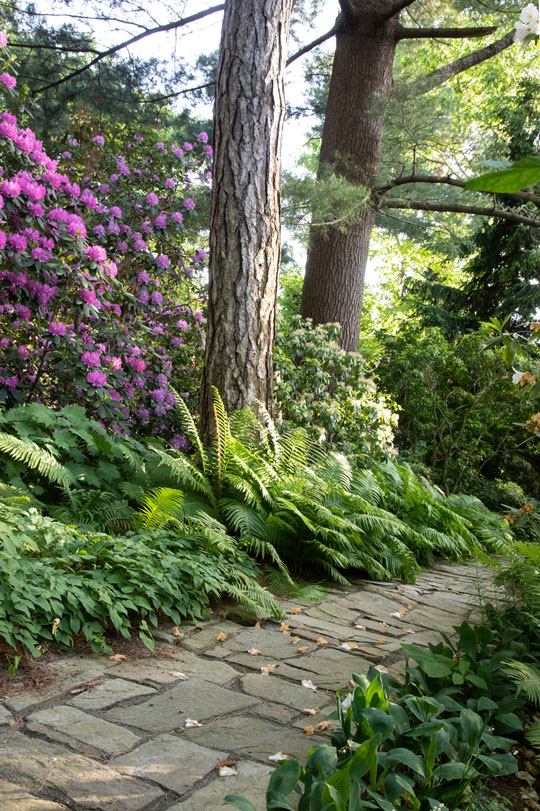
Minder Woods rises as a green belt between the Ruin and the great lawn below the Chanticleer House. Under a mature canopy of firs, oaks, and pines, the woodland garden contains a fair number of ericaceous shrubs, like azaleas, rhododendrons, and andromedeas, that prefer the cool and moist microclimate. One year, the discovery of morel mushrooms inspired a fungus-themed sitting area, including plant list box modeled on a shelf fungus. back to top
The Orchard
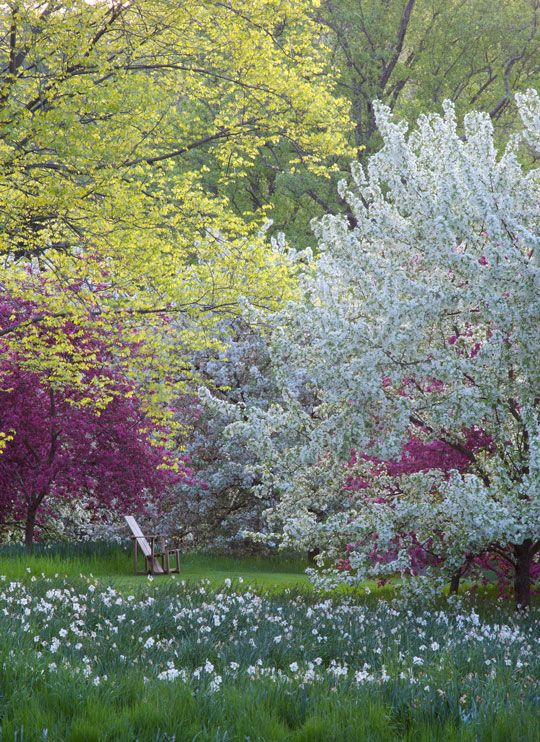
Crabapples and Japanese flowering cherries pay homage to what was once planted with fruit trees that produced for the Rosengarten household. Today’s Orchard is highlighted with cascades of white daffodils beginning with ‘Ice Follies’ and concluding with ‘Actaea’. Once these daffodils fade, the area reverts to lawn after the grass is cut in late June. back to top
Creek Garden

The Creek Garden is a verdant corridor that follows Bell's Run as it snakes towards the Pond Garden. In May, it’s a veritable wash of blue camassias that imbue the area with an Impressionist feeling. Simple bridges link the areas for pedestrian access.
The waterwheel was installed in the 1940s to pump water from the stream to the fountains on the Chanticleer Terraces. Although it no longer serves its original purpose, it now pumps water to a nearby fountain. All the acquatic features in The Creek Garden run only on water power. back to top
Bell's Woodland
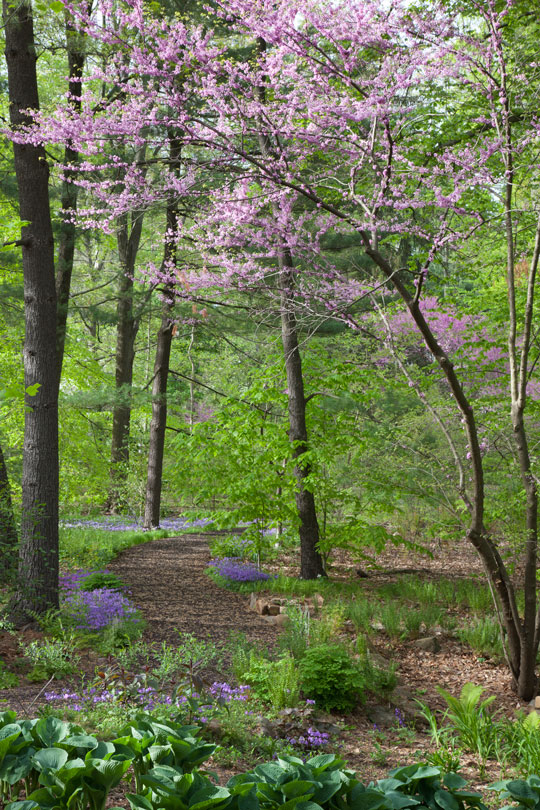
Heralded by a bridge built as a facsimile of a fallen tree, Bell’s Woodland celebrates the flora of eastern North American forests. This relatively new planting is still being developed The area is carpeted with spring ephemerals that capitalize on the short window of light between snowmelt and the trees fully leafing out. Spring beauties (Calytonia), trilliums, Virginia bluebells, and trout-lilies emerge with life-affirming optimism.
The main path elicits curious queries from visitors wanting to know the material responsible for its ‘bouncy’ feel – in fact, it is made from recycled tires and is permeable to water. A smaller, stone path meanders close to Bell's Run creek and sneaks under the fallen tree bridge. Here you'll find wetland plants including skunk cabbages, rushes, and sedges. back to top
The Vegetable Garden

Estates often had large, productive orchards and vegetable gardens. Chanticleer was no exception, having an orchard (now planted with crabapples and daffodils) and a large vegetable garden. Today’s Vegetable Garden is more modest and rustic in scale, yet productive and attractive. A fence safeguards plants against hungry rabbits. Each year the soil is generously dressed with compost and leaf mold to satisfy the high nutritional needs of vegetable crops. On a scale relatable to the homeowner wanting to grow produce in limited space, it demonstrates that with careful selection of varieties and successive planting, space constraints do not hinder productivity. Cucurbits spread on the fence and are trained on trellises to maximize vertical space. Herbs whose aromatic foliage make them less palatable to pests are planted outside the fence’s periphery. We share the produce with local food banks, shelters, and our staff. back to top
The Cutting Garden
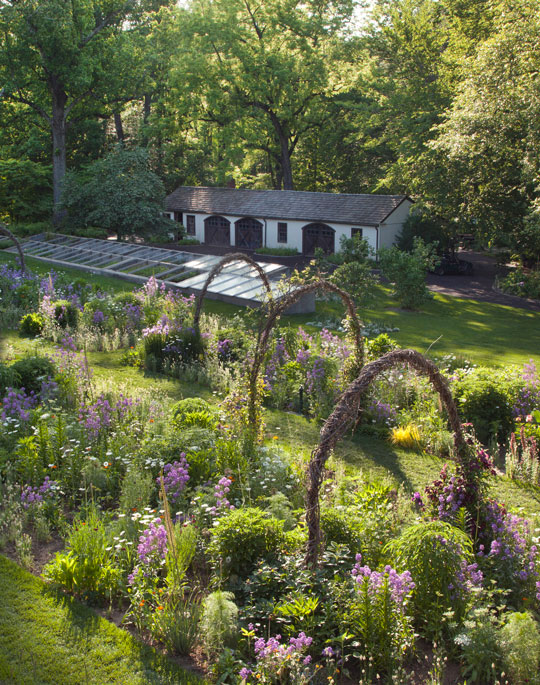
Staff cut flowers and foliage from this area to create floral arrangements to grace our welcome pavilion, rest rooms, and the Chanticleer House. Depending on the season, tulips, zinnias, celosias, and chrysanthemums are a few of the popular cut flowers with the staff. The garden also includes vegetables harvested and given to local food banks and shelters. The cold frames that line the cuting garden are essentially unheated greenhouse and extend the growing season.
Near the potting shed are an grand pair of katsura trees whose arching boughs reach out like outstretched arms and whose heart-shaped leaves emit a caramel aroma in autumn. Native to Japan and China, these trees are believed to have been planted in the 1930s. back to top
Opening Times
Wednesday - Sunday
10am - 5pm
Parking reservations are required until
3pm Wednesdays-Sundays.
Friday Evenings
The garden will be open until 8pm through Labor Day.
Parking reservations are required until 6:30pm.
Due to limited parking, we cannot accommodate groups on Friday evenings.
Picnicking is permitted only in the picnic areas, except on Friday evenings from 4-8pm, guests may picnic anywhere in the garden.
We ask guests to carry out what they bring in.
Early Saturdays in 2025
We open at 8:00am on the following Saturdays:June 7, July 5, August 2,
September 6, October 4,
and November 1.
Regular admission fees apply and Parking reservations are required.
2025 Season Pass
Purchase a 2025 Season Pass, good through November 9, 2025. Buy your pass now.
House and Garden Tours
Held every Thursday, Friday and Saturday at 11am.
Learn more and register here.
Garden Highlights Tour
Held every Wednesday and Saturday at 2pm.
Learn more and register here.
News & Events
Biodiversity Survey
We are proud to announce the release of our Biodiversity Survey, which outlines the impact that our garden has on the insect and animal populations that we intersect with.
Listen to Bill Thomas on Margaret Roach's podcast, A Way to Garden, as they discuss the Biodiversity Survey.
Read the Full Report
Garden Design Workshop
July 26-29, 2025
Register Here
Chanticleer Emails
Stay current - Sign up
Chanticleer In the News
High praise from 6ABC, WNEP, and The New York Times.
Chanticleer is committed to providing a safe, welcoming, and inclusive environment for the public and is an equal opportunity employer.




